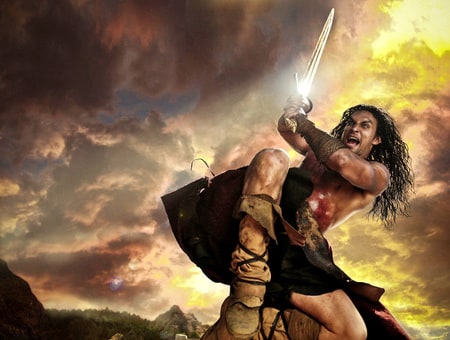It would be erroneous for you to approach 2011's Conan the Barbarian believing it to be a remake of the 1982 Arnold Schwarzenegger vehicle of the same name. The 1982 picture was pure camp; a cheesy, not-to-be-taken-seriously fantasy romp with Arnie playing his usual screen persona rather than the character of Conan as originally envisioned. Disposing of campy '80s instincts, director Marcus Nispel and writers Thomas Dean Donnelly, Joshua Oppenheimer and Sean Hood went back to the source for this 2011 flick to produce something closer to Robert E. Howard's original Conan stories. Lavish, violent and vicious, this Conan the Barbarian is the movie that Howard's followers have been waiting for.

Born in the middle of a battle and raised by his Cimmerian warrior father Corin (Perlman), Conan (Momoa) grows up to be the fiercest, most skilled fighter in his tribe. During Conan's childhood, an evil overlord known as Khalar Zym (Lang) and his sorceress daughter (McGowan) raid Conan's village seeking the final piece of an enchanted headdress. In the process, Zym kills Conan's father and destroys everything the boy knows and loves. Years later, Conan still looks to exact revenge on Zym, and traverses the lands developing his skills as a barbarian. During his travels, he winds up defending a young female monk of pure blood named Tamara (Nichols), who's being pursued by Zym.
With its standard-issue revenge plotline and no twists or surprises, there's nothing much in Conan the Barbarian that you haven't seen before. In fairness, though, Howard's first Conan stories were released in 1932, so it would be virtually impossible to be original when dealing with such ancient source material. Plus, the character of Conan has never been associated with complex stories; he's known as a barbarian, after all, and thus he spends his time slaughtering people. To the credit of the writers, 2011's Conan the Barbarian does a great job of for the most part keeping Conan Conan. Admittedly, however, some of the dialogue is pretty terrible and at least a bit of innovation would have been nice.

At the helm of Conan the Barbarian was Marcus Nispel, who directed the unforgivably bad 2007 Viking film Pathfinder. Nispel's presence behind the camera here did not inspire a great deal of confidence, but it seems that the director is improving in the art of creating cinematic junk food. Conan the Barbarian has tonnes of action, most of which was handled well by Nispel. There's a lot of gloriously violent carnage to behold, on top of epic battles involving sand creatures and sea serpents. The picture was produced on a bold budget of around $90 million, and therefore it's aesthetically pleasing - solid CGI permeates the film, bringing this swords-and-sorcery world to vivid life with extravagant results. On the other hand, though, Nispel still has a bit to learn. A number of action beats are marred by shaky-cam, close-ups and rapid-fire editing, while pacing issues do arise from time to time. Most critically, the tone is uneven - some battles are delightfully violent and satisfying, but other instances of violence feel sadistic and uncomfortable.
At least in this reviewer's mind, a lot of scepticism surrounded the choice of Jason Momoa as the titular badass. However, against all odds, Momoa is an excellent Conan; intense, convincing and always in-the-moment. He matches the role physically, and he has that gleam in his eye whenever the character is in his barbaric element. While his screen presence is not quite as strong as Schwarzenegger's, Momoa is a better actor than the Austrian Oak ever was. Leo Howard also deserves a mention for playing baby Conan; he inhabits a good 20 minutes of screen-time, and makes a good impression. Meanwhile, Avatar's Stephen Lang is effectively sinister and scene-stealing as Khalar Zym. Indeed, Lang demonstrates here yet again that he's a reliably badass antagonist. Alongside Lang is Rose McGowan, who's at her scenery-chewing best playing Zym's sorceress daughter. Rounding out the cast is a strong Ron Perlman as Conan's father, and Rachel Nichols who's rather forgettable as the token love interest. Morgan Freeman is also on-hand as the narrator; a job he fulfilled magnificently.

Those who've based their affection for Conan on Arnie's linguistically-challenged version probably shouldn't bother with 2011's Conan the Barbarian. And those without a taste for action who enjoy something subtler should not go anywhere near this production. However, if you're seeking an enjoyable action romp, this picture will serve your needs nicely in spite of its flaws. It has been criticised for being overly violent, but hey - it has the word "barbarian" in its fucking title, so tasteless barbarianism comes with the territory and toning this shit down would be stupid. Considering its strengths, it's a true shame that this Conan the Barbarian failed at the box office; it could've been the start of a new big-budget Conan franchise. Instead, what we have is just a strong origins tale that's unlikely to lead anywhere.
Note: This reviewer did not view the film in 3-D, but by all accounts the extra-dimensional effects are utter bollocks.
6.5/10
 Login
Login
 Home
Home 183 Lists
183 Lists 1667 Reviews
1667 Reviews Collections
Collections
 0 comments,
0 comments, 


































